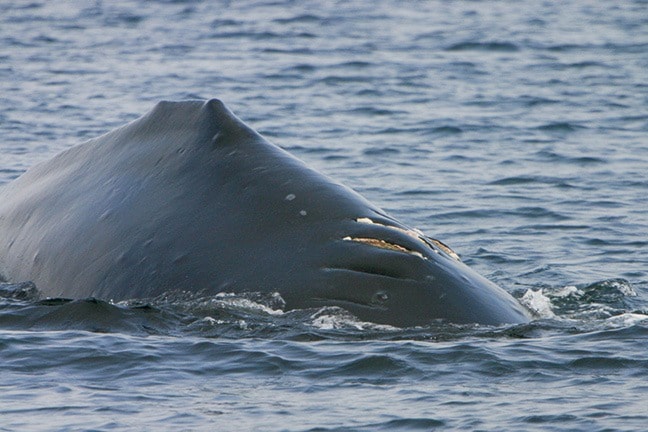Terry Farrell
Record staff
With the increased presence of humpback whales in our waters comes the need for education and awareness on how to handle sightings.
The Marine Education and Research Society has launched a campaign, called "See a Blow, Go Slow," in an effort to reduce the risk of collisions between boaters and whales.
“Humpbacks have come back from the brink of extinction and have literally changed the landscape of coastal British Columbia,” said Jackie Hildering, a MERS education and communications director, and humpback researcher. “We've got a second chance with these animals, but with that comes a needed awareness as to what is safe behaviour, not just for the whales, but for the boaters.”
Hildering stressed that while many boaters on the West Coast are familiar with the characteristics and swimming habits of orcas, humpbacks are not at all the same.
“The huge difference is that killer whales are toothed whales that have biosonar,” said Hildering. “Killer whales are most often travelling in a linear direction and are highly surface active. Killer whales are big dolphins - they are only about eight metres long.
“Humpbacks are a baleen whale that are not known to have biosonar. They can be astoundingly unaware of boats. They are most often not travelling in a linear direction. They are generally feeding in our waters, so they can surface very, very unpredictably, and most importantly, they are giants. You're dealing with animals as big as school buses.”
In short, they're dangerous, because they are unpredictable.
There are numerous things boaters can do to protect themselves and the animals from any inadvertent strike, which could cause severe damage, not only to the animal, but also to the vessels and those aboard.
“It's important, if you know there is a humpback around, not to position yourself anywhere near a 'bait ball' (small school of fish, easily identified by large clusters of birds on the surface). If there are any humpbacks around, they are likely to surface within that area,” said Hildering. “They can suddenly surface, after long dives, and they are highly acrobatic.
“If you see a humpback, it's advisable not to move in closer. The Be Whale Wise guidelines (see http://www.seeablowgoslow.org/), which suggest 100 metres for a killer whale, that's not enough, depending on what the humpbacks are doing. You want to maintain your distance, be alert that they could surface, certainly not get any closer than, say, 200 metres.
“People think this is only about whale safety, but it's very much about human safety.”
Hildering was concerned with reports of jet-skis and motorboats attempting to corral the humpbacks around the Comox Marina last week.
She said not only is it a dangerous practice, but it's also against the law.
“There definitely are shortcomings in the regulations that exist, but it comes down to ‘you may not disturb a marine animal.’ As long disturbance can be proven, charges can be laid under the Fisheries Act,” said Hildering.
There have been documented cases of collisions with humpback whales that have not ended well for the boaters, including one case from 2013, where the boater, in an unavoidable collision with a humpback, was seriously injured and needed reconstructive facial surgery afterwards.
“Even this summer, there was an incident in Campbell River, where a whale was hit not once, but twice, by boats, and one boat was actually lifted up into the air.
“There's one humpback out there - we believe it's the one that is very often around Campbell River now - and he's got a big gash on his back, as a result of getting hit.”
Another humpback whale, 'Slash', is described by Hildering as being the "poster child" for what can happen as a result of contact with boats.
“She has a terrible huge prop scarring down her back (see accompanying photo),” said Hildering. “It was probably done by a tugboat. Who wants to hurt any animal, let alone a protected species? But it can happen.”
Hildering said boaters and humpbacks can share the water - it's a matter of being educated and aware.
“You just need to be alert,” she said. “If you see a blow, either shut down, or proceed really slowly. Be aware of areas of density of humpbacks, and be aware that even if the whale goes down, it could come up right away again.
“We are so fortunate to have them back, to have a second chance with these amazing animals... there just needs to be an awareness that there's a new kid on the block. And he's a really big kid.”
